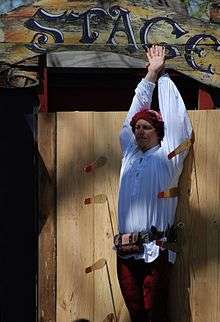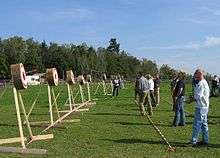Knife throwing

Knife throwing is an art, sport, combat skill, or variously an entertainment technique, involving an artist skilled in the art of throwing knives, the weapons thrown, and a target.
Basic principles
Knife throwing, whether in a martial or sport application, involves the same basic principles of mechanics. The objective in each case is for the point to stick into the target with a sufficient amount of force. For this to be successful, accuracy, distance, number of rotations and placement of the body all must be taken into account.
If the thrower uses a spin technique, the knife will rotate during flight.[1] This means that the thrower, assuming they are throwing the same way every time, must either choose a specific distance for each type of throw or, more practically, make slight adjustments to the placement of the knife in the hand or to the throwing movement.[2] Another adjustment that can be made is the way the knife is held. If it is held at the blade when it is thrown, this makes it spin half, whereas if it is held by the handle, this makes a full spin. So if the thrower estimates he needs one and a half spins for the point to hit the target, he would hold the knife from the blade when it is thrown. If he feels he needs two full spins for it to hit the target point-first, then it would be held by the handle.
With the much more intricate no spin throwing techniques, the throwing motion is made as linear as possible, the knife's rotation being slowed down even more by an index finger on the spine during release.[3] Thrown no spin, knives will make no revolution or only a quarter spin before reaching the target (point first), but the no spin throws are not as accurate or stable in flight as the spin techniques. The knife does not need to be sharp to stick, as long as it has a point, it will stick into your target.
Sport

In the USA and in many European countries, there are communities of people pursuing knife throwing as a sport, similar to archery. For example, in Europe more than 25 knife throwing clubs[4] exist.
The competition itself consists, in the most common form, of a series of straight throws aimed at a set of standard wooden targets or in some cases foam. Similar to an archery target, competition knife throwing targets have a bullseye surrounded by one or more rings. A sticking knife scores points. The thrower must be standing at least a set distance away from the target, with higher distances for more challenging events. IKTHOF keeps a ranking[5] of its members based on their performance during these sponsored competitions. EuroThrowers maintains a register of the world records[6], and for each championship publishes the full scores together with the meetings' reports[7].
Martial arts
Although it was popularized in the US in the late 19th century by traveling acts such as the Barnum & Bailey Circus, the history of knife throwing dates much further back. The art of knife throwing was first used in martial arts or hunting applications. It has been incorporated into the martial disciplines of the Japanese as well as some African and Native American tribes. In such cases, throwing a weapon when fighting is generally thought of as a risk. If unsuccessful, it can leave the thrower without a weapon and arm his attacker. However, many warriors traditionally carried two or more weapons at the same time.
Representations
The opera Queen of Knives, which premiered in Portland, Oregon on May 7, 2010 tells the story of a brother and sister knife throwing act in the midst of the student protests in Birmingham in the early 1960s.[8]
See also
Notes and references
- ↑ "Physics of knife throwing". Retrieved 8 July 2013.
- ↑ "Knife throwing training". Retrieved 1 October 2014.
- ↑ "No spin knife throwing". Retrieved 28 October 2014.
- ↑ "List of knife throwing clubs in Europe". Retrieved 25 June 2018.
- ↑ "IKTHOF knife rankings (USA)". Retrieved 3 April 2018.
- ↑ "Eurothrowers world records". Retrieved 3 April 2018.
- ↑ "Eurothrowers championship reports (EU)". Retrieved 3 April 2018.
- ↑ McQuillen, James, Opera review: "Portland's Vagabond Opera's 'Queen of Knives' is one sharp show", The Oregonian, May 11, 2010
Sources
- Collins, Blackie. Knife Throwing-Sport – Survival – Defense. Knife World Publications, 1978. ( ISBN 0-940362-03-1)
- Echanis, Michael D. Knife Fighting: Knife Throwing for Combat. Ohara Publications, 1978. ( ISBN 0-8975-0058-X)
- Hibben, Gil. The Complete Gil Hibben Knife Throwing Guide. United Cutlery Corp., 1994. (ASIN-B0006FAV9E)
- Madden, James W. The Art of Throwing Weapons. Patrick Publications, 1991. ( ISBN 0-9628825-3-4)
- McEvoy, Harry K. Knife Throwing: A Practical Guide. Charles E. Tuttle Company, Inc., 1973. ( ISBN 0-8048-1099-0)
- McEvoy, Harry K. Knife and Tomahawk Throwing. Knife World Publications, 1985. ( ISBN 0-940362-10-4)
- McEvoy, Harry K. Knife & Tomahawk Throwing-Art of the Experts. Charles E. Tuttle Company, Inc., 1988. ( ISBN 0-8048-1542-9)
- Moeller, Harald. Knifethrowing: The Viper Story. Lynclif Publishing, 1988. ( ISBN 0-921444-00-1)